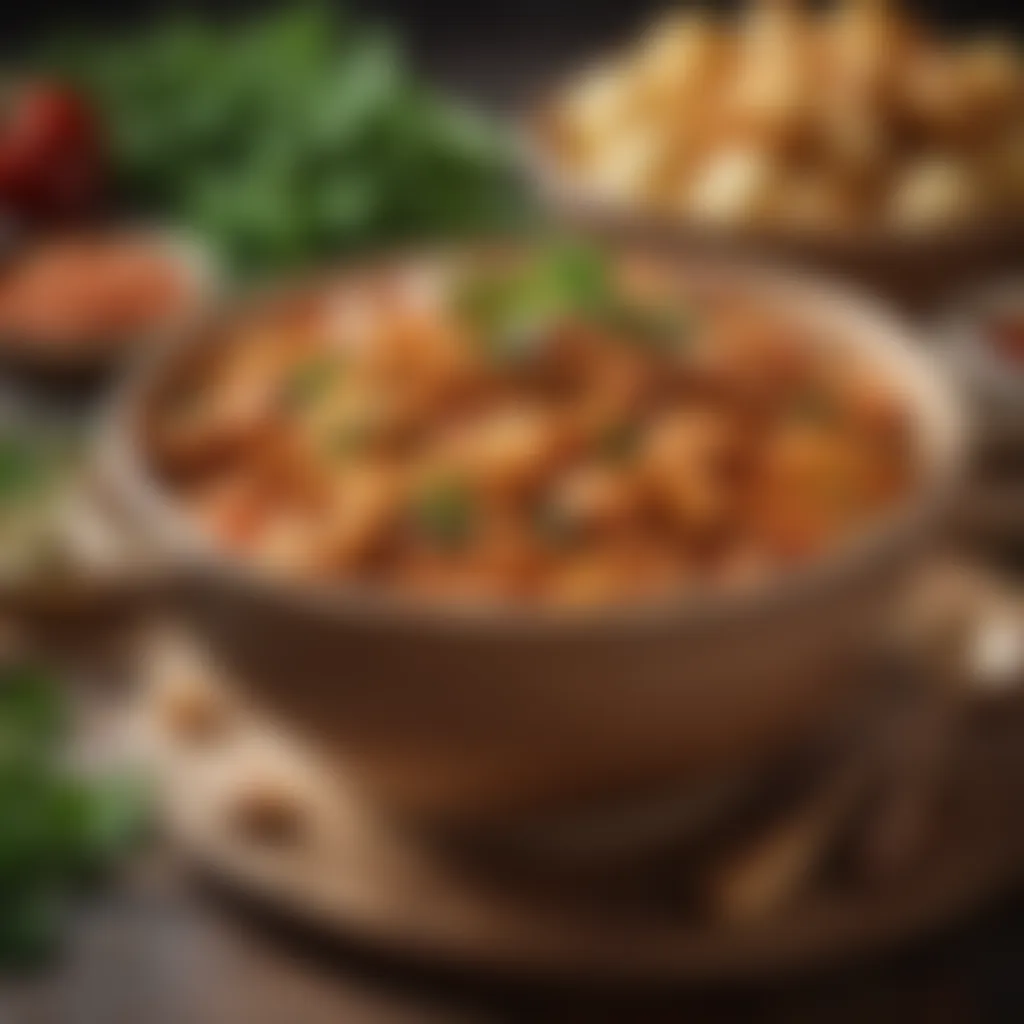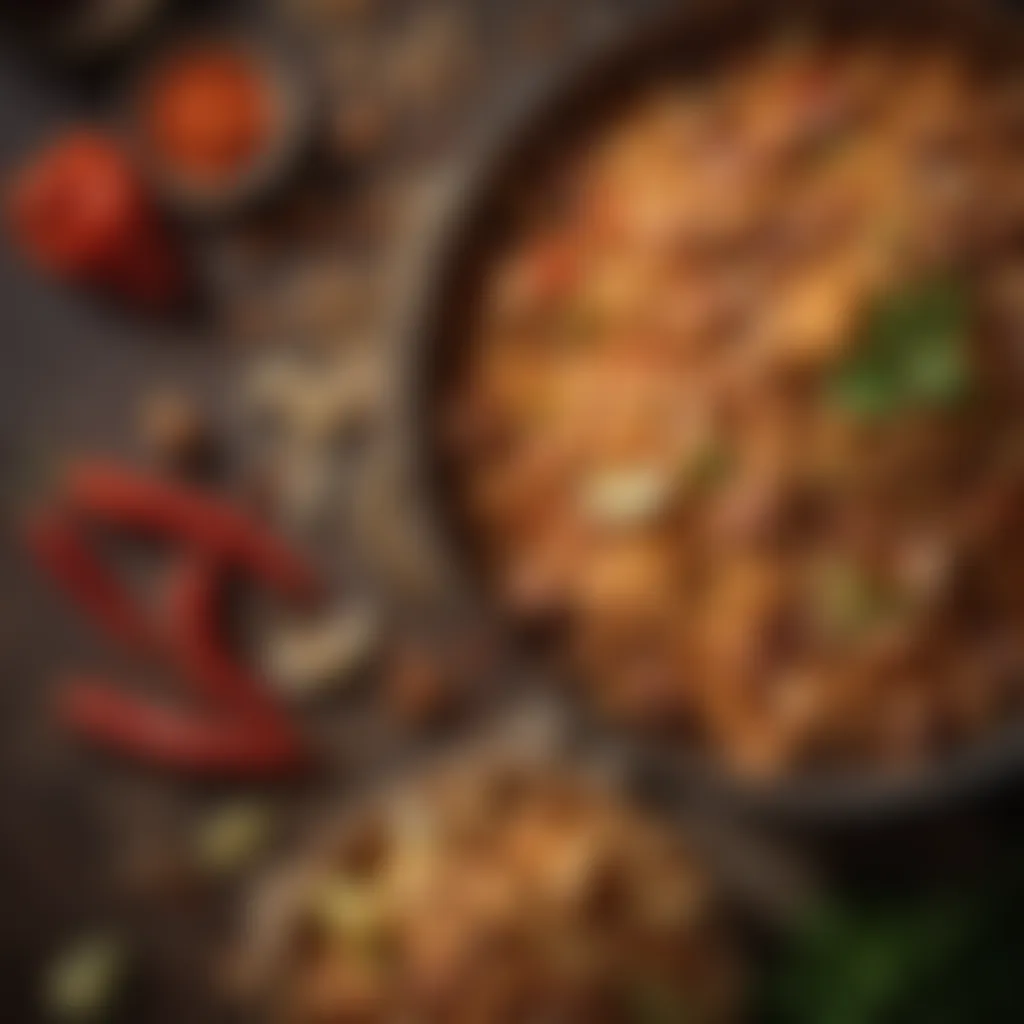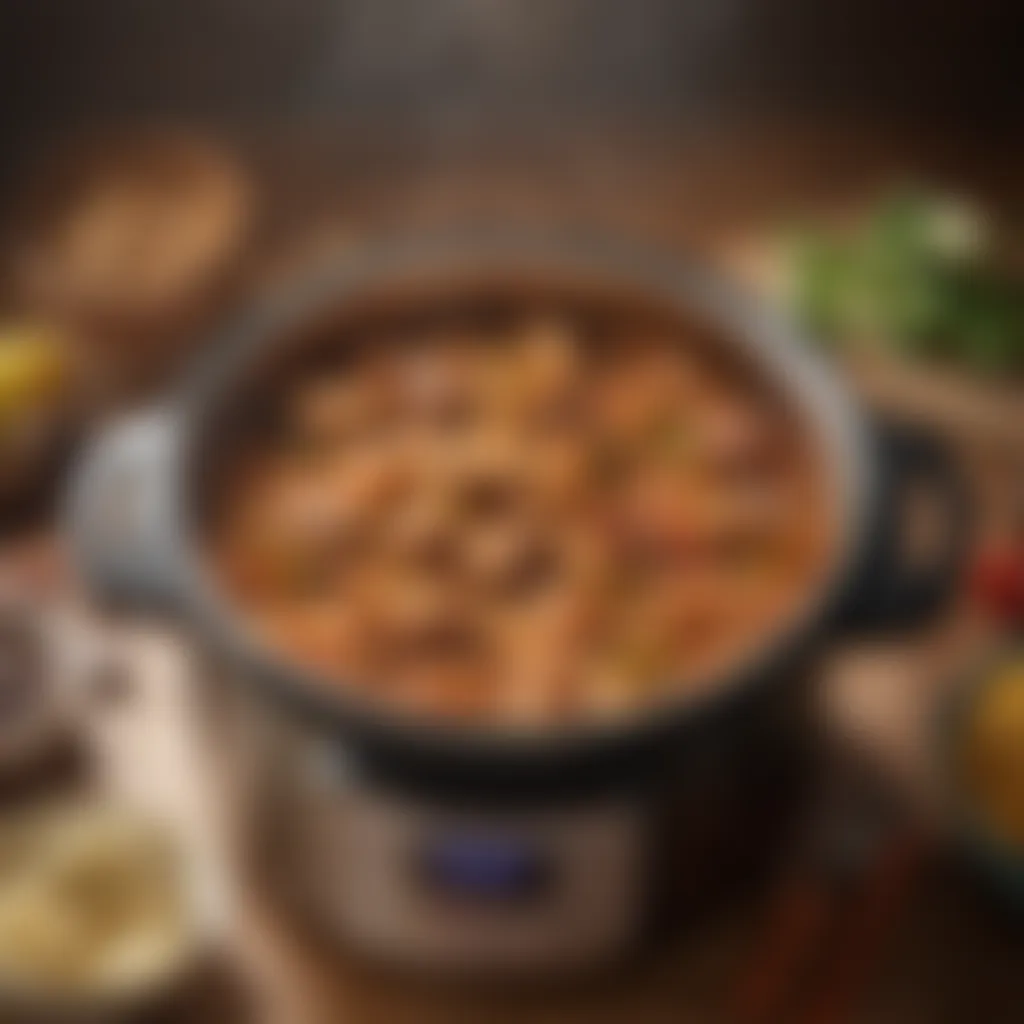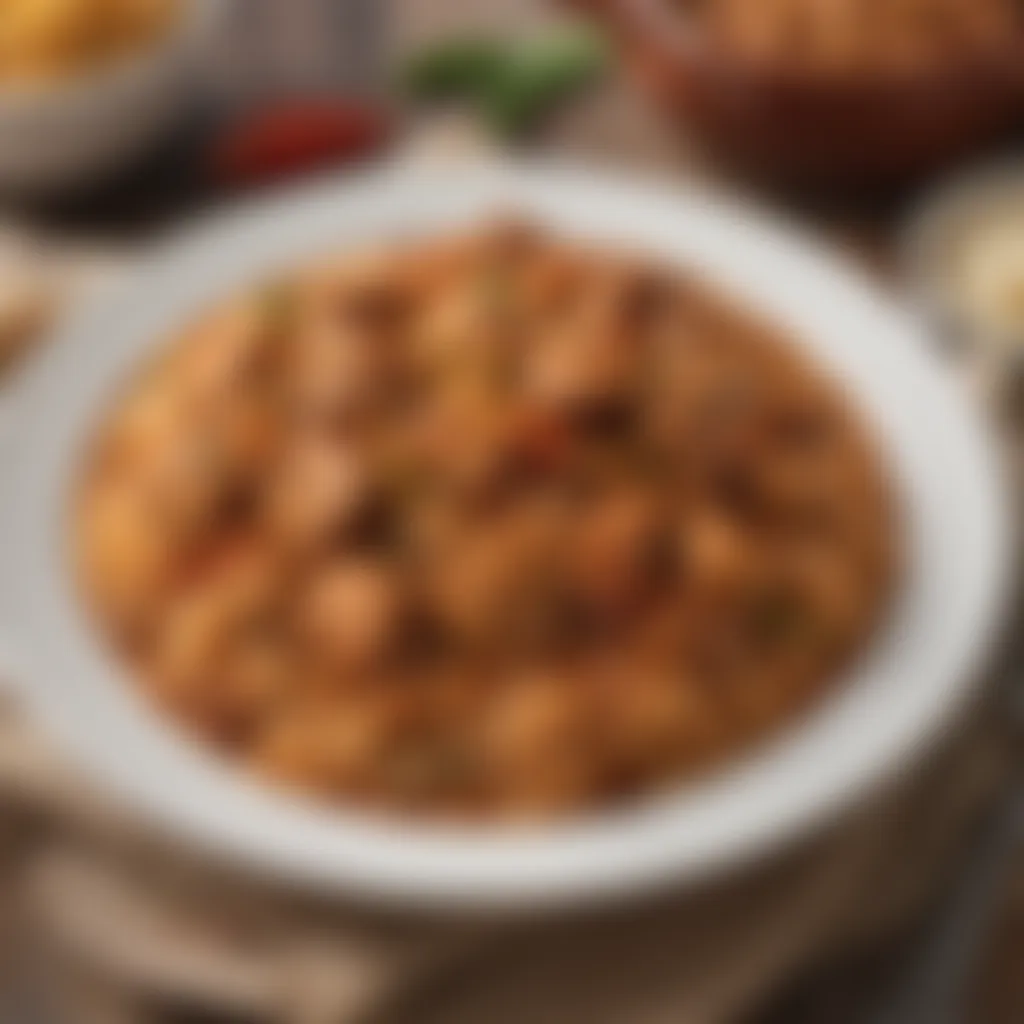Mastering Instant Pot Jambalaya: A Culinary Guide


Intro
Jambalaya is more than just a meal; it is a tapestry of cultures woven together from African, French, and Spanish influences. Preparing jambalaya, especially in an Instant Pot, not only simplifies the cooking process but also preserves the rich flavors of this beloved dish. In this comprehensive guide, we will explore the ingredients, preparation steps, and cooking techniques that make Instant Pot jambalaya a noteworthy addition to your culinary repertoire.
Ingredients:
To create a delightful Instant Pot jambalaya, you need the following ingredients:
- 1 lb chicken thighs, boneless and skinless, cut into bite-sized pieces
- 1 lb smoked sausage, sliced (Andouille is a popular choice)
- 1 medium onion, finely chopped
- 1 bell pepper, chopped (any color will do)
- 2 stalks celery, chopped
- 4 cloves garlic, minced
- 1 can (14.5 oz) diced tomatoes, with juices
- 2 cups chicken broth
- 1 cup long-grain rice, rinsed
- 2 tablespoons Cajun seasoning
- 1 teaspoon dried thyme
- 1 bay leaf
- Salt and pepper, to taste
- 2 tablespoons olive oil
- 1 lb shrimp, peeled and deveined (optional)
- Chopped green onions, for garnish
Preparation Steps:
Preparing jambalaya in an Instant Pot requires attention to detail and step-by-step execution. Here’s how:
- Prepare all ingredients: Chop the vegetables, slice the sausage, and rinse the rice. This preparation will keep everything organized for a smooth cooking experience.
- Season the chicken: Sprinkle the chicken thighs with salt, pepper, and half of the Cajun seasoning. This allows the flavors to penetrate the meat while cooking.
- Sauté the ingredients: Turn on the Instant Pot and set it to 'Sauté' mode. Add olive oil and let it heat up. Once hot, add the seasoned chicken and sausage. Cook until browned, about 5-7 minutes. Stir frequently to avoid sticking.
- Add vegetables and garlic: Toss in the onion, bell pepper, celery, and garlic. Sauté until the vegetables are translucent, around 3-4 minutes.
Technical Aspects:
Understanding some technical points is crucial for achieving optimal results:
- Instant Pot Settings: The 'Sauté' mode is essential for browning proteins and vegetables. After that, switch to 'Manual' mode for pressure cooking.
- Timing: The total cooking time after pressure is built should be around 10-12 minutes for the rice and proteins to cook thoroughly.
- Pressure Release: At the end of cooking, allow for a natural release for about 5 minutes before switching to a quick release to avoid overcooking.
Cooking Process:
- After sautéing, pour in the diced tomatoes, chicken broth, rinsed rice, bay leaf, thyme, and remaining Cajun seasoning. Stir well to combine.
- Close the lid: Make sure the sealing valve is set to 'Sealing' position.
- Set Cooking Time: Select 'Manual' and set the timer for 10 minutes.
- Once the timer goes off, let the pressure release naturally for 5 minutes, then switch to a quick release. Carefully open the lid.
- If using shrimp, add them now and stir. Close the lid for a couple more minutes until shrimp are cooked through.
- Remove bay leaf before serving.
Troubleshooting Tips:
Cooking is often a trial and error process. Here are some common adjustments:
- Rice is undercooked: In case the rice is not fully cooked after the initial time, you can add a small amount of broth and set the Instant Pot to 'Sauté' for an additional few minutes.
- Dish is too watery: If there’s excess liquid, turn on 'Sauté' mode and stir gently until it reduces to your desired consistency.
- Adjust spice levels: If the dish needs more heat, consider adding a few dashes of hot sauce or extra Cajun seasoning before serving.
Foreword to Jambalaya
Jambalaya is a dish that holds a special place in the hearts of many, especially those who appreciate the rich tapestry of flavors found in Creole cuisine. Its preparation and ingredients tell a story that transcends mere cooking. Understanding jambalaya helps one appreciate not just its taste but its cultural relevance. This section sets the stage for exploring this exquisite dish, focusing on its fine nuances.
Historical Background of Jambalaya
Jambalaya's roots can be traced back to the Spanish and French influences that permeated Louisiana. When Spain took control of New Orleans, they brought their methods of cooking rice. This introduction, combined with the French boudin sausage, laid the groundwork for jambalaya. The exact origin is not solely agreed upon; however, it often embodies a blend of different cultures.
In the 19th century, jambalaya started appearing in cookbooks, which helped solidify its place in New Orleans' culinary tradition. The dish typically includes rice, meat, vegetables, and spices, each ingredient contributing to its distinctive character. Importantly, jambalaya was originally a way to utilize leftover ingredients, making it not just a delicious meal but a resourceful one too. This aspect highlights the historical significance of the dish as practical and inventive cooking, which resonates with many home cooks today.
Significance in Creole Cuisine
In the realm of Creole cuisine, jambalaya stands out as a dish that showcases the diverse cultural influences that define this culinary tradition. It is not just a meal but a celebratory dish often served at gatherings or special events. The preparation of jambalaya also reflects the community spirit, as families often come together to create it.
Creole cooking itself is an intersection of French, Spanish, West African, and Native American influences. The jambalaya reflects this mosaic, bringing together various aspects of these cultures into one pot. It's important to recognize how jambalaya encapsulates the essence of New Orleans—its historic roots, local ingredients, and the social dynamics of the city.
The dish's flexibility makes it a perfect canvas for creativity. Every cook can put their personal twist on it while still preserving its core identity. Through this adaptability, jambalaya continues to evolve and remains an integral part of Creole cuisine, ensuring its relevance for future generations.


The Instant Pot: An Overview
The Instant Pot is more than just a kitchen appliance; it represents a significant shift in how many approach cooking. Challenging traditional methods, it stands out for its versatility and ease of use. In this article, we analyze its role in preparing jambalaya, a dish that benefits greatly from its unique features.
Understanding the Instant Pot Functionality
The Instant Pot combines several cooking methods in one device. It functions as a pressure cooker, slow cooker, rice cooker, steamer, and even a sauté pan. This multifunctionality allows for various cooking styles, making it ideal for intricate dishes like jambalaya.
- Pressure Cooking: Reduces cooking time dramatically. It tenderizes meats and melds flavors efficiently.
- Sauté Function: Begins the cooking process by browning meats or vegetables before pressure cooking.
- Slow Cooking: Provides the option to prepare meals over a longer time frame, enhancing flavors.
The ability to regulate temperature and pressure automatically is crucial. This functionality minimizes the risk of burning or overcooking, which is vital for achieving the perfect texture in jambalaya.
Benefits of Cooking with an Instant Pot
Using the Instant Pot has clear advantages, especially when making jambalaya. These benefits include:
- Time Efficiency: Cooking time is significantly reduced without sacrificing flavor or texture.
- Flavor Retention: Pressure cooking retains moisture and intensifies flavors. The ingredients mingle in a way that traditional methods may not achieve.
- Less Supervision Required: You can set it and let it do its work. This feature frees up time to attend to other kitchen tasks or family activities.
- Easy Cleanup: Most models come with a non-stick inner pot, simplifying the cleanup process.
"The Instant Pot not only serves practical advantages but also enhances the joy of cooking by saving time and effort."
In summary, the Instant Pot is an essential tool for modern cooking. Its integration into dishes like jambalaya showcases its practicality, efficiency, and ability to maintain the integrity of flavors. As you proceed with making jambalaya, understanding this appliance will guide you to a more enjoyable cooking experience.
Essential Ingredients for Jambalaya
The journey of making jambalaya begins with understanding the essential ingredients that contribute both to the flavor and to the identity of this iconic dish. Each ingredient plays a crucial role in creating a harmonious blend of tastes and textures. Focusing on these components makes it easier to achieve an authentic jambalaya experience. The quality and proportions of the ingredients can elevate your dish from ordinary to extraordinary.
Base Ingredients: Rice, Protein, and Vegetables
Rice serves as the foundation of jambalaya. It absorbs the flavorful broth, enhancing the overall dish with its texture. Selecting a suitable rice variety is important; usually, long-grain rice like Basmati or Jasmine works well. The starch content in these types prevents the dish from becoming too mushy.
Protein choices are diverse and depend on personal preference. Common options include chicken, andouille sausage, shrimp, or a mixture. Each protein adds its own distinct flavor. Mixing meats can create a depth of flavor, reflecting the diverse cultural influences in jambalaya.
Vegetables introduce freshness and color. The holy trinity of Cajun cooking—onions, bell peppers, and celery—forms the base. They should be diced finely and sautéed until tender. Other vegetables can include tomatoes and peas, which add further layers of flavor and texture. Determining the right balance between protein and vegetables is a key consideration to ensure overall harmony in the dish.
Spices That Define Jambalaya
Spices are the soul of jambalaya. They give the dish its characteristic flavor profile. A blend of spices can vary, but common ones include paprika, cayenne pepper, oregano, thyme, and black pepper.
The key to achieving the right spice level lies in balance. Too much heat can overshadow the subtler flavors, while too little can yield a bland outcome. Adding spices at different stages of cooking can develop the flavors further; for example, sautéing spices briefly can enhance their aroma and taste significantly.
Choosing the Right Broth
Broth forms the liquid base that infuses the rice and ingredients with flavor. Choosing between chicken, seafood, or vegetable broth will impact the overall taste greatly. Homemade broth is an ideal option, as it can provide a richer flavor, but store-bought options can also work well in balancing convenience and taste.
When selecting broth, consider sodium levels. A low-sodium broth allows for more control over the dish's saltiness. Adding broth incrementally is a practical approach. This ensures that the rice absorbs just the right amount of liquid without becoming overly wet or dry. It also enables some flexibility based on your preferences or dietary restrictions.
Understanding these essential ingredients is fundamental in preparing a successful jambalaya. Ignoring their significance can lead to an imbalanced dish that does not showcase the dish's rich history and flavor potential.
Preparing Jambalaya in the Instant Pot


Preparing jambalaya in the Instant Pot offers a unique opportunity to blend tradition with modern convenience. This section emphasizes how the Instant Pot can simplify the cooking process while still delivering the rich flavors associated with this classic dish. Understanding the functionality of the Instant Pot enhances the overall cooking experience, allowing even novice cooks to achieve professional results.
Prepping Ingredients: A Detailed Guide
The key to a successful jambalaya lies in how well the ingredients are prepped. While gathering the necessary components, it is essential to choose the right type of rice. Long-grain rice, like basmati or jasmine, typically works best as it remains fluffy.
Essential Preparations Include:
- Chopping Vegetables: Onion, bell peppers, and celery are known as the "holy trinity" in Creole cooking. Finely chop these ingredients to allow for even cooking and flavor distribution.
- Selecting Proteins: Depending on your variation, you might choose chicken, sausage, or seafood. If using chicken, cut it into bite-sized pieces. For sausage, slice it into rounds. Seafood should be cleaned and deveined as necessary.
- Measuring Spices: Jambalaya gets its character largely from spices. A combination of cayenne pepper, paprika, thyme, and bay leaves should be prepared in advance to ensure balanced flavor.
Taking the time to prepare these ingredients properly sets the stage for a delightful culinary experience.
Step-by-Step Cooking Process
The cooking process in the Instant Pot differs from traditional methods, but it remains straightforward once your ingredients are ready. Begin by using the sauté function of the Instant Pot. This step is crucial as it helps develop flavors before pressure cooking.
- Sauté the Aromatics: Start by adding a touch of oil in the pot, then sauté onions, bell peppers, and celery until they are soft and fragrant.
- Cook the Proteins: Introduce your proteins next. Cook until they are browned, ensuring even heat.
- Add Spices and Rice: Sprinkle the prepared spices into the mix, stirring well. Pour in the rice, coating it evenly with oil and spices. This technique helps the rice absorb flavors better.
- Pour in the Broth: Finally, add the broth, ensuring to scrape up any bits stuck to the bottom of the pot. This step adds depth to the finished dish.
- Seal and Cook: Close the lid, set the valve to sealing, and cook on high pressure for about 10 to 12 minutes, allowing the flavors to meld beautifully under pressure. In many cases, you would want to follow with a natural pressure release for better results.
Adjusting Cooking Times for Different Ingredients
Different ingredients can alter the cooking time. Understanding how to adjust for these differences ensures that every component is cooked perfectly.
- Vegetables: Harder vegetables like carrots may need a couple of extra minutes compared to softer vegetables like peas.
- Chicken: Bone-in chicken might require about 3 to 5 additional minutes compared to boneless cuts.
- Seafood: If you are using shrimp or fish, a quick 4 to 5 minute pressure cooking is usually adequate. Overcooking seafood can lead to rubbery texture.
Adapting cooking times depends on the ingredients’ type and cut sizes. This awareness keeps the balance of textures in jambalaya, delivering an exceptional result.
"Understanding the interplay of ingredients and cooking times is key to mastering any dish, especially one as intricate as jambalaya."
By following these detailed prepping, cooking, and adjusting techniques, even a busy home chef can create an authentic and mouth-watering jambalaya using the Instant Pot.
Variations of Instant Pot Jambalaya
The beauty of jambalaya lies in its adaptability. Variations of Instant Pot jambalaya allow both culinary creativity and accommodate different dietary preferences. Each variation brings a unique flavor profile and character to the dish. This section illuminates several key adaptations, ensuring that anyone can enjoy a version that caters to their taste. These variations not only make jambalaya accessible but also enhance the cooking experience with diverse ingredients.
Seafood Jambalaya
Seafood jambalaya is a delightful twist that highlights the flavors of the ocean. This version often incorporates shrimp, crab, or mussels. The freshness of seafood elevates the dish, creating a light yet satisfying meal. To prepare seafood jambalaya in an Instant Pot, one must consider the cooking time carefully. Seafood cooks faster than meats, and overcooking can lead to a rubbery texture.
The key ingredients typically include:
- Shrimp: Fresh or frozen, deveined.
- Crab: Either lump crab meat or claw meat for deeper flavor.
- Mussels: Cleaned and debearded.
- Fish Stock: For an added umami boost, using fish stock instead of chicken or vegetable stock is beneficial.
Cooking seafood jambalaya doesn't stray far from traditional methods.
- Use the sauté function to cook the vegetables, as you would in any jambalaya.
- Add the rice and stock, then cook under pressure for a specific time, usually shorter than with meat.
- Stir in the seafood once the pressure releases, and let it steam in the residual heat.
Vegetarian Options
For those who prefer plant-based meals, vegetarian jambalaya is a wonderful choice. This variation maintains the hearty, robust flavor profile of traditional jambalaya while avoiding meat. Ingredients play a critical role in achieving depth and richness. One can enhance flavor with the right selection of vegetables and spices.


Common ingredients in vegetarian jambalaya include:
- Bell Peppers: A mix of colors adds visual appeal and flavor.
- Zucchini: Adds a tender bite.
- Mushrooms: Provides an earthy flavor, resembling the umami qualities of meat.
- Canned Tomatoes: Offers acidity and moisture to the dish.
Preparation is similar. The main deviation lies in the cooking time. It’s essential to ensure the rice cooks properly without losing the vegetables' texture. Consider using vegetable broth for a richer taste.
Spicy Chicken and Sausage Jambalaya
This variation introduces a fiery kick and hearty ingredients. Spicy chicken and sausage jambalaya showcases the delightful combination of chicken thighs and flavorful sausage, commonly Andouille. The distinct spices used enhance the heat, culminating in a warming dish perfect for gatherings.
Essential ingredients typically involve:
- Chicken Thighs: Thicker than breasts, they retain moisture.
- Andouille Sausage: Sliced for distribution of flavor.
- Cayenne Pepper: For added heat.
- Paprika: To complement the spice with smokiness.
The process begins with sautéing the sausage and chicken until browned. This step builds flavor intensity.
- Add onions, garlic, and other vegetables to enhance the base.
- Incorporate rice and broth, then pressure cook until the rice is fully cooked.
- Finish by incorporating additional spices for a balanced heat level.
Tips for Perfecting Jambalaya
Perfecting jambalaya is a process that requires attention to several key factors. Each element impacts the overall taste and quality of the dish. By applying these tips, one can achieve a well-rounded and flavorful jambalaya that captures the essence of this classic dish while also being easy and efficient to prepare in an Instant Pot.
Achieving the Right Flavor Balance
Balance in flavor is crucial for an authentic jambalaya. Each ingredient should complement the others without overwhelming them. Key components include the protein, spices, and vegetables. Start with quality proteins such as chicken, sausage, or shrimp, ensuring they are well-seasoned before cooking. Evaporating excess water, either from the broth or the protein, can significantly affect taste. For the spice mix, use a blend of paprika, cayenne, thyme, and bay leaves, and adjust according to personal preference.
- Tip: Add spices early in the cooking process to fully develop their flavors.
- Tip: Taste throughout the cooking to ensure a perfect flavor profile.
Moreover, the quality of the broth is paramount. Fresh, homemade stock will enhance the dish, while store-bought can sometimes lack depth. Enhancing the broth with herbs or a splash of hot sauce can also elevate the flavor profile.
Storage Techniques for Leftovers
Proper storage of jambalaya is essential for maintaining its quality. Always allow the dish to cool to room temperature before storing. Use airtight containers to minimize exposure to air, which can lead to spoilage. Leftover jambalaya can be refrigerated for up to three days or frozen for extended storage. If freezing, consider portioning the jambalaya into smaller containers, making it easy to defrost only what you need.
- Tip: Label containers with dates to keep track of freshness.
- Tip: Avoid storing jambalaya with seafood or delicate ingredients if you plan to keep it longer.
Reheating and Serving Suggestions
When reheating jambalaya, ensure it is warmed evenly. The Instant Pot can be used again to reheat, set to the sauté mode, stirring gently to prevent sticking. Alternatively, reheating on the stove over low heat works well too. Add a splash of broth or water to prevent drying out.
Serving jambalaya can be versatile. Traditionally, it is served in bowls, but it can also be plated as a side with other dishes. Garnishing with fresh parsley or green onions adds a touch of color and freshness.
"A well-prepared jambalaya is not just a meal; it is an experience to be cherished."
Epilogue
The conclusion of this guide serves to encapsulate the journey through preparing jambalaya using the Instant Pot. It is vital to understand that jambalaya is more than just a meal. It embodies cultural heritage, culinary techniques, and personal creativity. In this article, we have explored various aspects from the historical significance of jambalaya to its intricate ingredients and cooking methods. This detailed examination offers not just a recipe but a lens through which one can appreciate the depth of Creole cuisine.
Reflecting on the Culinary Experience
Reflecting on the culinary experience allows us to appreciate the layers involved in making jambalaya. Each step, from ingredient selection to the final plating, offers an opportunity for personal expression. Cooking in the Instant Pot can enhance this experience as it simplifies the process while preserving flavors. Home cooks can enjoy the ease of preparation without sacrificing quality. Every bite of jambalaya tells a story, connecting the past with the present through its vibrant flavors.
Encouragement for Experimentation
Culinary creativity is encouraged when making jambalaya. While traditional versions have their appeal, there is room for personalization. Feel free to modify ingredients according to preference. Whether it is spicing up the dish with additional seasonings or substituting proteins, the Instant Pot allows for flexibility. Experimentation can lead to new favorites that reflect individual tastes. Remember, cooking is as much about discovery as it is about tradition. Embrace the journey, and enjoy the process of creating your own signature dish!







